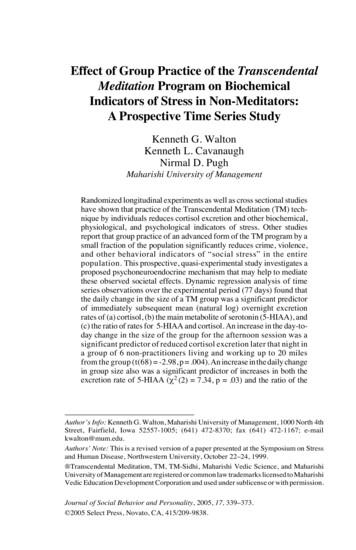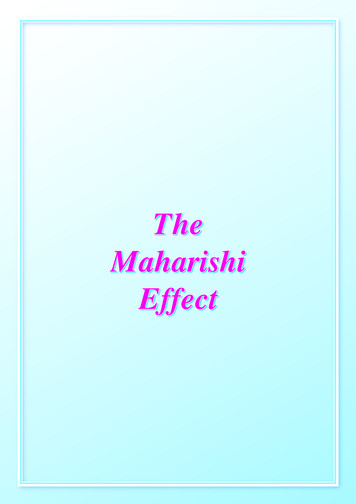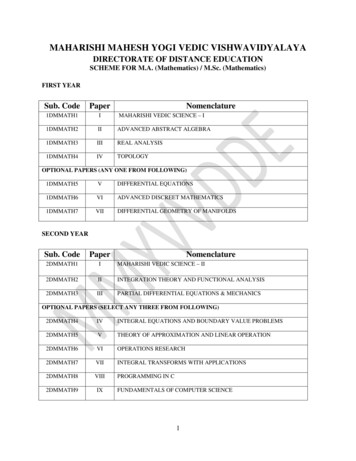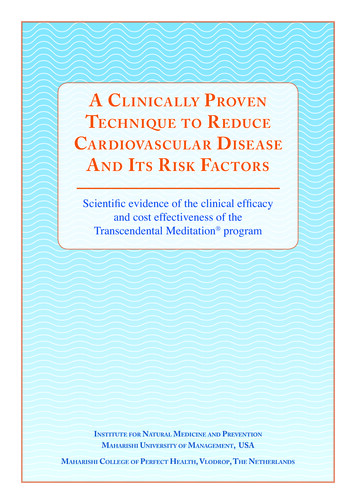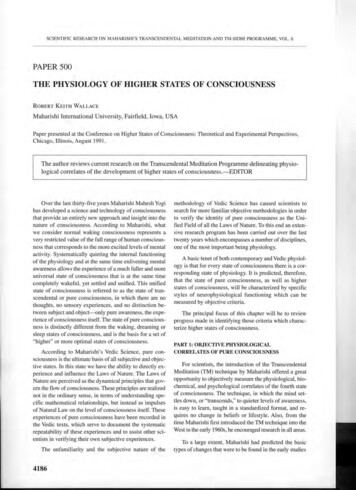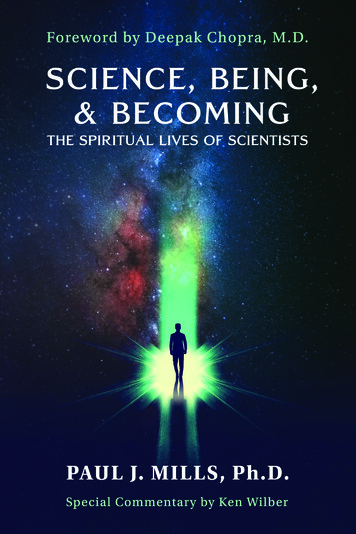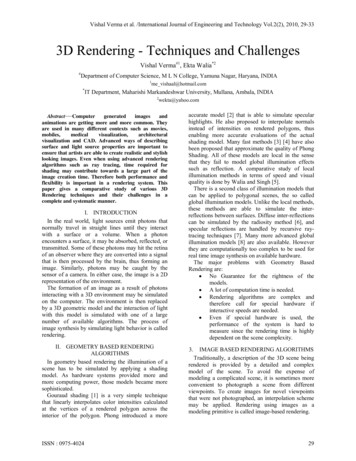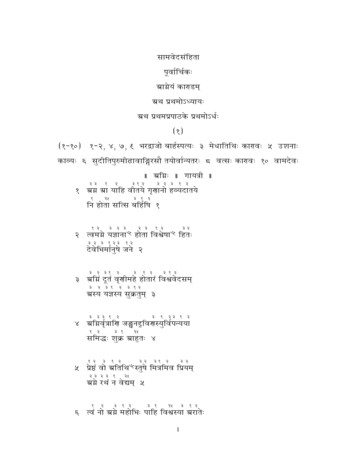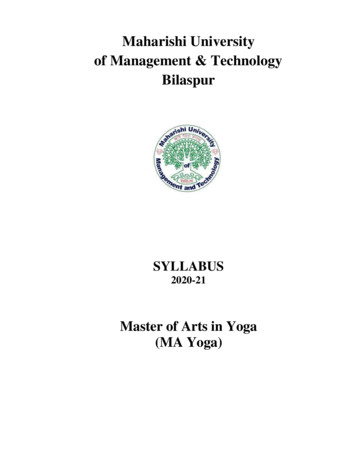
Transcription
Maharishi Universityof Management & TechnologyBilaspurSYLLABUS2020-21Master of Arts in Yoga(MA Yoga)
Maharishi University of Management & Technology, BilaspurMaster of Arts in YogaSyllabus of MA (Yoga)I. Title of the ProgrammeThe programme shall be called "Master of Art in Yoga” (MA Yoga)II. Aim of the ProgrammeThe aim of the programme is to produce "Yoga teacher as a paramedical professional"III. Objectives of the programmea. Prevention: To introduce yoga therapy, its principles and practices of yoga for prevention ofvarious lifestyles, non-communicable and psychosomatic disorders. Promotion of positivehealth: To prepare them for giving talks and offer techniques to promote healthy yogic life style.b. Treatment: To create professional yoga teacher/instructor of high calibre who know theconcepts, techniques and can handle lifestyle disease under the guidance of a super specialistdoctor to select safe specific practices for different diseases.c. To create yoga therapy experts with in-depth knowledge based on yogic texts. For example, totrain them ‘be and make’ i. e., ensure they practice what they teach.d. Social health: To establish holistic health, social harmony and world peace by training them tobe great citizens who can offer yogic way of life as examples of right living.IV. DurationThe minimum duration of the programme will be 2 years (4 semesters) and the maximumduration will be four years.V. EligibilityThe candidate should have completed Bachelor Degree in any subject from any UGC recognizeduniversity.VI. Scheme of Teaching and Examination
Maharishi University of Management & Technology, BilaspurMA in Yoga1st YearFirst SemesterPaper- I Foundation of YogaPaper- II Hatha YogaPaper- III Shrimadbhagvad Geeta & SamkhyakarikaPaper- IV Human Biology- IPaper- V Yoga PracticumPaper- VI Human Biology Practicum-ISecond SemesterPaper- I Patanjal Yoga DarshanPaper- II Indian Philosophy & CulturePaper- III Yoga PsychologyPaper- IV Human Biology-IIPaper- V Yoga PracticumPaper- VI Human Biology Practicum-II2nd YearThird SemesterPaper- I Methods of Teaching Yoga and Value EducationPaper- II Introduction to AyurvedaPaper- III Research & Statistical MethodsPaper- IV NaturopathyPaper- V Yoga PracticumPaper- VI Naturopathy PracticumForth SemesterPaper- I Hygiene, Diet & NutritionPaper- II Yoga TherapyPaper- III Complementary & Alternative TherapyPaper- IV Dissertation / Field TrainingPaper- V Yoga PracticumPaper- VI Complementary & Alternative Therapy Practicum
Maharishi University of Management & Technology, BilaspurM. A. (Yoga)First SemesterPaper-IFoundation of YogaTotal Marks (Internal & Final Exam): 100 (70 30)Objectives: The teaching-learning of this paper will enable learner toi. Give an introduction of yoga and its important streams,ii. Give a brief introduction of Indian Philosophy; andiii. Give a brief history and the basis different yoga.Unit - 1: General Introduction to Yoga and Indian PhilosophyBrief introduction to origin of Yoga, Psychological aspects leading to origin of Yoga, Historyand Development of Yoga; Etymology and Definitions of Yoga, Aim and Objectives of Yoga,Misconceptions about Yoga, True Nature of Yoga; General Introduction to Schools (Streams) ofYoga, Principles of Yoga and Yogic practices for healthy living; Meaning and definitions ofDarshana and Philosophy, Salient features of Indian Philosophy; (Bharateeya darshana),Branches of Indian Philosophy (Astika and Nastika Darshanas); Two-way relationship betweenYoga and Indian Philosophy; General introduction to Prasthanatrayee and PurusharthaChatushtaya.Unit - 2: Foundations of Yoga and Yoga Traditions- IGeneral introduction to Vedas and Upanishads, Yoga in Pre-vedic period, Yoga in Vedic period,Yoga in Ayurveda, Yoga in Principle Upanishads, Yoga in Yogopanishad; General introductionto Shad-darshanas, Yoga in Samkhya and Yoga Darshana, Yoga in Vedanta; Generalintroduction to Bhagavadgita, Yoga in Bhagavadgita; Introduction to Smritis and Yoga inSmritis, Introduction to Puranas, Nature of Yoga in Bhagavat Purana; Yoga in Yoga Vasishtha,Yoga in Narada Bhakti Sutra, Yoga in Medival Literature, Bhakti Yoga of Medival Saints.Unit - 3: Foundations of Yoga and Yoga Traditions - IIGeneral introduction to Agamas, Tantras and classification of Tantras, Concept of Shiva andShakti, Yoga of Shaiva Siddhanta; Yoga in Shakta Tantra: Concepts of Nadi and Prana in Tantra,Kundalini, Effects of Kundalini Shakti and Shatchakra Sadhana, Hatha Yoga Traditions andSadhana.Unit - 4: Foundations of Yoga and Yoga Traditions - IIIGeneral Introduction to Non-Vedic Schools of Indian Philosophy: Jainism, Buddhism, etc.;Introduction to Jainism, Anekantavada (Syadvada), Concept of Tri-ratnas, Concept ofKayotsarga (Preksha-dhyana). Yoga in Jaina darshana; Introduction to Buddhism: Inroduction toBuddhism, Skandha-vada, Concept of Arya-satya or Four Noble Truths, Arya-astangikamarga orNoble-eight-fold-path (Bouddha-Yoga)Unit - 5: Concept and Implications of Important Yogic Streams: Jyan Yoga, Bhakti Yoga,Karma Yoa, Ashtang Yoga, Kriya Yoga, Hatha Yoga, Tantra Yoga and Mantra yoga.TEXT BOOK1. Dasgupta S. N: History of Indian Philosophy, Motilal Banarsidas, Delhi, 2012
2. Sharma, Chandradhar: A Critical Survey of Indian Philosophy. Motilal Banarasidas, Delhi,2013BOOKS FOR REFERENCE1. Agarwal M M : Six systems of Indian Philosophy, Chowkhambha Vidya Bhawan, varanai,20102. Swami Bhuteshananda: Nararad Bhakti Sutra, Advaita Ashrama Publication-Dept. Kolkata, IIEdition, 20093. Hiriyanna M : Outlines of Indian Philosophy, Motilal Banarsidas, Delhi, 20094. Bhat, Krishna K.: The Power of Yoga: SuYoga Publications Mangalore, 20065. Swami Prabhavananda : Spiritual Heritage of India (English). Sri Ramkrishna Math,Madras, 20046. Swami Vivekananda : Jnana Yoga, Bhakti Yoga, Karma Yoga, Raja Yoga. AdvaitaAshrama, Calcutta, 20007. Pandit, M. P.: Introduction to Upanishads: Theosophical Society of India, Adyar, Madras,19768. Dasgupta, S.N. : Hindu Mysticism, Motilal Banarsidass,Delhi 19279. Arthuv Avalan : The Serpent Power, Sivalik Prakashan, New Delhi, 200910. Bhat, Krishna K. : The Power of Yoga: SuYoga Publications Mangalore, 200611. Sing, Lalan Prasad : Tantra, Its Mystic and Scientific Bases. Concept Publishing Company,Delhi,197612. Karel Werner : Yoga and Indian Philosophy, Motilal Banarasidas, Delhi, 197913. Swami Jnanananda : Philosophy of Yoga. Sri Ramakrishna Ashrama, Mysore.1415161718192021-;ksx n'kZu;ksx lw ;ksx lw jktekrZ.Mikraty ;ksx izn hiikraty ;ksx foe'kZ/;ku ;ksx izdk'k;ksx n'kZuikraty ;ksx n'kZu&&&&&&&&Lokeh jkensookpLifrfeJHkkstjktvksekuUn rhFkZfot;iky 'kkL hy{ke.kkuUnjktkjke 'kkL h ¼2002½Lokeh lR;ifr ifjozktd ¼2002½
Maharishi University of Management & Technology, BilaspurM. A. (Yoga)First SemesterPaper-IIHatha YogaTotal Marks (Internal & Final Exam): 100 (70 30)Objectives: The teaching-learning of this paper will enable learner toi.To give an introduction of Hatha yogaii. To give an understanding of the prerequisites of Hatha Yogaiii. To introduce the principles of Hatha Yogaiv. To introduce essential Hatha Yoga textUnit-1: Hatha Yoga Its Philosophy and PracticesHatha Yoga, its meaning, definition, aims & objectives, misconceptions, obstacles (vighna) andhelps (sahayaka) in Hatha Yoga as in Hatha Yoga Pradépika; The Origin of Hatha Yoga, HathaYogic Literature, Hatha Yogic Practices as explained in Hatha Yoga Pradépika (HYP); Conceptof Mata, Rules & Regulations to be followed by the Hatha Yoga Practitioner, concept ofMitahara, Pathya and Apathya ; Hatha Yogic parampara. Brief introduction to Great HathaYogi’s of Natha Cult and their contributions to Yoga. Relationship between Hatha Yoga & RajaYoga.Unit-2: Hatha Yoga Practices: Shodhana-Kriyas and AsanasShodhana-kriyas, SHodhana-kriyas in Hatha Yoga Pradépika & in Gheranda Samhita and theirtechniques, benefits and precautions; Role of SHodhana-kriyas in Yoga Sadhana and theirimportance in Modern day life; Yogasana: its definition, Salient features and importance inHatha Yoga Sadhana; Asanas in Hatha Yoga Pradépika and Gheranda Samhita: their techniques,benefits, precautions and importance.Unit-3: Hatha Yogic Practices: Pranayama, Bandhas and MudrasPranayama – Machanism of correct breathing, Yogic deep breathing, Concept of Püraka,Kumbhaka and Recaka; The concept of Prana, Kinds of Prana and Upa-pranas, Pranayama andits importance in Hatha Yoga Sadhana, Nadishodhana Pranayama, its technique and importance,Pre-requisites of Pranayama; Pranayama practices in Hatha yoga pradépika and GherandaSamhita, their techniques, benefits and precautions, Hatha Siddhi Lakshanam; Bandhas and roleof Bandhatrayas in Yoga Sadhana; Fundamental Mudras in HYP and G.S, Their techniques,benefits and precautions.Unit-4: Hathayoga Practices: Pratyahara, Nadanusandhana & Svarodaya JnanaConcept of Pratyahara, Dharana and Dhyana in Gheranda Samhita and their techniques &benefits; Concept of Samadhi in Hatha-yoga Pradépika, Samadhi Lakshanam and Hatha YogaSiddhi Lakshanam; The concept of Nada, Four Avasthas (stages) of 7 Nadanusandhana, and itsSiddhis; Svara, Importance of Svarodaya-jnana in Yoga Sadhana with special reference to JnanaSvarodaya and Shiva Svarodaya.Unit-5: Introduction to Hathayogic Texts & their ImplicationsIntroduction to Basic Hatha Yoga Texts: Basic Hatha Yogic Texts: their nature and objectives,Siddhasiddhantapaddhati, Goraksha Samhita, and Shiva Samhita, Hatha Pradeepika, GherandaSamhita, Breif introduction to Hatha Rathnavali. Applications of Hatha Yogic Practices as
elementary practices of Raj Yoga and Holistic Health Promotion, Disease Prevention,Rejuvenation, Healing and Age Reversal.TEXT BOOKS1. I. K. Taimini : The Science of Yoga, (The Theosophical, Publishing House, Adyar Chennai2005).2. Swami Satyananda Saraswati : Hatha Yoga, Pub: BSY MungherBOOKS FOR REFERENCE:1. Woods, J.H. : The Yoga System of Patanjali, M.L.B.D., Delhi, 19882. Swami Vivekananda: Rajayoga, Advaita Ashram, Culcutta, 20003. Iyengar B.K.S. : Light on Patanjal Yoga (New York, Schocken Books, 1994)4. Swami Sri Omanandatirtha: Patanjala Yoga Pradeepa, Geeta Press, Gorakhapur, 19945. Swami Anant Bharati : Patanjali Yoga Shasta- a study (Hindi), Swami KeshwanandaYoga Sangthan, Delhi, 19826. Burley, Mikel: Hatha Yoga, Its’ Context Theory and Practice (M.L.B.D. Delhi, 2000)7. Ghosh, Shyam: The Original Yoga, Munshiram Manoharlal, New Delhi, 19998. Burnier, Radha: Hathayoga Pradipika of Svatmarama, The Adyar Library publications,Chennai. 200010. Woodroffe, Sir John: The Serpent power (Ganesh & Company, Madras, 2000)11121314151617-gB iznhfidkxksj[k lafgrkxksj{k lafgrkHkfDr lkxjmifu"kn laxzgcfgjax ;ksx;ksxklu foKku&&&&&&&Lokeh dqoY;kuUn] dSoY;/kke] yksukoykLokeh fnxEcj th] ,e,y ?kjkSVs ¼1997½ dSoY;/kkeMkW peuyky xkSre ¼1985½Lokeh pj.knkleksrhyky cukjlhnklLokeh ;ksxs'ojkuUnLokeh /khjsUnz czEgpkjh
Maharishi University of Management & Technology, BilaspurM. A. (Yoga)First SemesterPaper-IIIShrimadbhagvad Geeta & SamkhyakarikaTotal Marks (Internal & Final Exam): 100 (70 30)Aims of the Paper: The teaching-learning of this paper will enable learner to1) Understand and discuss Shrimadbhagvad Geeta & Samkhyakarika as basic philosophical andtheoritical foundations of Yoga.Unit- IHkkxon xhrk&lkekU; ifjp;A xhrk ds vuqlkj vkRek dk Lo:i] ;ksx ds fofHkUu y{k.k]fLFkr izKrk] deZ fl)kar] l f"V pØ dh ijEijk] yksd laxzgAUnit- IIdeZ;ksxh dh ijEijk] ;K dk Lo:i] Kku dh vfXu] lka[; ;ksx ,oa deZ;ksx dh ,drkAlU;kl dk Lo:i] eks{k esa lU;kl dh mikns;rk] deZ;ksxh ds y{k.k] czEgKku dk mik;]vH;kl vkSj oSjkX;] izdf r ,oa ek;kAUnit-IIIbZ'oj dh foHkwfr;ka] fojkV Lo:i] HkfDr ;ksx] f xq.k foospu] nSoklqj lEink foHkkx] f fo/kJ)kAUnit- IVlka[; n'kZu ifjp;A lka[;dkfjdkuqlkj nq[k dk Lo:i] iPphl rRoksa dk ifjp;] izek.kfoospu] lRdk;Zokn] vuqiyfC/k ds dkj.k] O;Dr vO;Dr foospuAUnit- Vlka[;dkfjdk ds vuqlkj xq.kksa dk Lo:i] iq:"k foospu] cqf) ds y{k.k ,oa /keZ] vgadkj lslxZ izo fRr] ;ksn'k dj.k] lw{e 'kjhj] eqfDr foospuAlanHkZ xzaFk&1- lka[;rRodkSeqfn&okpLifr feJ2- lka[;izopu Hkk";&foKkufHk{k3- lka[;dkfjdk&bZ'ojd ".k4- JhenHkxorxhrk&egf"kZ osnO;kl5- JhenHkxorxhrk&vkpk;Z 'kadj6- JhenHkxorxhrk&yksdekU; fryd7- JhenHkxorxhrk&lR;ozr fl)kUrkyadkj
Maharishi University of Management & Technology, BilaspurM. A. (Yoga)Paper-IVFirst SemesterHuman Biology- ITotal Marks (Internal & Final Exam): 100 (70 30)Aims of the Paper: The teaching-learning of this paper will enable learner to1) Discuss introduction to human body with concept of cells, tissues, skeletal system, muscularsystem, respiratory system, cardiovascular system with their gross anatomy and physiology.2) Discuss anotomical & physiological effects of selected yoga practices on aforesaid contents ofhuman body in evidence based way.Unit – 1 The cells & tissues of the human body, types, structure & functions of the cells; types,structure & functions of tissues (epithelial, connective, muscle, & nervous),Meaning of anatomical terms (median plane, directional terms & regional terms).Unit – 2 Skeletal System: Concept, Types & Functions; Bone: Concept, Types, Number, Grossanatomy & Physiology, & Functions, Bone Cells: Concept, Types & their Functions; SynovialJoints: Concept, types & their features, Spine: GrossAnatomy & Physiology and Functions; Yogic effect on Bone/Skeletal System.Unit – 3 Muscular System: Concept, Types &Functions; Muscles: Concept, Number, Types, &their Gross Anatomy & Physiology and Functions; Brief introduction , Yogic effect on MuscularSystem.Unit – 4 Respiratory System: Concept, Gross Anatomy & Physiology, Types &Functions;Lungs: Gross Anatomy & Physiolgy and Functions; Respiration: Concept, Types, GrossAnatomy & Physiology, Breathing Mechanics & Gaseous exchange; Respiratory Control Center;Yogic effect on Respiratory System.Unit- 5 Cardiovascular System: Concept, Gross Anatomy, Physiology, &Functions; Blood(RBC, WBC& Platelets): Concept, Composition & Functions; Heart: Gross Anatomy,Physiology, Innervation & Functions; Blood Groups; Blood Vessels (Artery, Vein & Capalliery):Gross Anatomy & Functions; Cardiac output, Blood Pressure, Circulation: Concept, Types &their mechanisms; Control of cardiac cycle & circulations; Effect of Yoga on Circulatory system.
REFERENCESBalkrishna, A. (2007). Yoga in synergy with medical science. Haridwar, India: Divya PrakashanBooksTMCoulter, H. D. (2006). Anatomy of Hatha Yoga. Delhi, India: Motilal BanarasidasFrawley, D. & Kozak, S. S. (2006). Yoga for your type. New Delhi, India: New Age Books.Gore, M.M. (2004). Anatomy and physiology of yogic practices. Lonavala, India: Kanchan Prakashan.Gupta, A.P. (2011). Human anatomy and pshysiology. Agra, India: Sumit Prakashan.Guyton, A.C. & Hall, J.E. (2006). Text book of medical physiology (11th ed.). Pennsytvania: Elseveir.Kaminoff, L. (2007). Yoga Anatomy. Champaign: Human KineticsMalshe, P. C. (2012). A Medical Understanding of Yoga (2nd ed.). Haridwar, India: Antar Prakash Centerfor Yoga.McCall, T. (2007). Yoga as Medicine: The Yogic Prescription for Health and Healing. NewYork, NY: Bantam Dell.Pandya, K.K. (1998). Human anatomy. Varanasi, India: Krishnadas Academy.Patanjali Research Foundation. (2015). Research Publications. Haridwar, India: DivyaPrakashan.Ramdev, S. (2006). Yoga Sadhana and Yoga Chikitsa Rahasya. Haridwar, India: DivyaPrakashan.Ramdev, S. (2009). Pranayam Rahasya. Haridwar, India: Divya Prakashan.Robin, Mel. (2002). A physiological handbook for teachers of yogasana. Arizona: FenestraRobin, Mel. (2009). A Handbook for Yogasana Teachers. Arizona: Wheatmark@Selvarasu, K. V. (2003). Kriya Cleansing in yoga. Tamil Nadu, India: Yoga Bharati.Tortora, G.J. & Derrickson, B.N. (2009). Principles of anatomy and physiology-I (14th ed.). Hoboken, NJ:Wiley.Tortora, G.J. & Derrickson, B.N. (2009). Principles of anatomy and physiology-II (14th ed.). Hoboken,NJ: Wiley.Udupa, K. N. (2007). Stress and its management by yoga. Delhi, India: Motilal BanarasidasWaugh, A. & Grant, A. (2010). Ross and Wilson: Anatomy and Physiology in Health and Illness (11 thed.). London: Elsevier.Khalsha, S., Cohen, L., Call, T. & Telles, S. (2016). The principle and practice of yoga in health care
Maharishi University of Management & Technology, BilaspurM. A. (Yoga)First SemesterPaper-VYoga PracticumTotal Marks (Internal & Final Exam): 100 (70 30)Aims of the Paper: The teaching-learning of this paper will enable learner to1) State techniques, health benefits, applications, precautions and contraindications ofunder mentioned yogic practices; &2) To demonstrate and instruct under mentioned yogic practices."kVdeZ%tyusfr] jcjusfr] oeu] /kkSfr@dqatj fØ;k] okrdeZ] dikyHkkfrA15 vadvklu%30 vadlw{e O;k;ke ¼ioueqDrklu Hkkx&1½] 12 vklu ¼e.Mwd vklku] 'k'kdklu] xkseq[kklu]oØklu] edjklu] Hkqtaxklu] 'kyHkklu] deZVklu] ioueqDrklu] v)Zgyklu]ikno Rrklu] f} pØhvklu] o ueRL;klulqIrotzklupØklurkM klufr;Zd rkM klu,dikn iz.kkeklu o {kklux:MklugLrksrkukluiknLrkluf v)Zineklu,dikn gyklulsrqca/kkludeZVklu'k'kkadklufoijhr ke%10 vadMk;kQzkfed czhfnax] izk.kk;ke% dikyHkkafr] HkfL dk] ckg;] mTtk;h] vuqykse&foykse ]ukM h'kks/ku] Hkzkejh ,oa mnxhFkAeqnzk ,oa ca/k% Kku eqnzk] fpu eqnzk] foijhr dj.kh] ;ksxeqnzk] tkya/kjca/k] mMMh;kuca/k]ewyca/kA10 vadekSf[kdh%10 vad
Maharishi University of Management & Technology, BilaspurM. A. (Yoga)First SemesterPaper-VIHuman Biology Practicum-ITotal Marks (Internal & Final Exam): 100 (70 30)The objectives behind teaching Anatomy and Physiology is to Make students familiar with the systems of the body. Give a hand on experience about the human body using models, charts and pictures. Make students understand the organization of the body with respect to structural components.Unit-1: Demonstration of Osteology & Myology [15 Hrs.]Unit-2: Demonstration of Organs & Viscera regarding Cardio-pulmonary Systems [15Hrs.]Unit-3: Demonstration of Bones, and Joints [15 Hrs.]Unit-4: Demonstration of Human Skeleton [15 Hrs.]
Maharishi University of Management & Technology, BilaspurM.A. (Yoga)Second SemesterPatanjal Yoga DarshanTotal Marks (Internal & Final Exam): 100 (70 30)Objectives:i. To teach an overview of the Patanjali Yoga Sutrasii. To teach the essence of the Patanjali Yoga Sutrasiii. To discuss Patanjali Yoga Sutra in terms of PsychologyUnit-1: Philosophy & Practices of Patanjali Yoga Sutra and Modern PsychologyYoga, its meaning & purpose & a brief introduction to Patanjali’s Yoga Sutras and its author;Nature of Yoga according to Patanjali in light of Vyasabhashya and other traditionalcommentators, Importance of Yoga Sütra in comparison to other Yogic literature; Concept ofCitta, Citta-bhumis, Citta-vrittis, Citta-vritti nirodhopaya (Abhyasa and Vairagya) CittaVikshepas (Antarayas), Citta-prasadanam and its’ associates; Metaphysics of Saìkhya & its’relationship with Yoga Darshana of Patanjali, Philosophical Foundations & Practices ofPatanjali’s Yogas, its’ importance & relevance and Yoga Samanvaya; Concept of mind – easternand western perspective; psychology principles and methods – TA, etc.Unit-2: Samadhi Pada and Sadhana PadaKriya-yoga, Theory of Kleshas, Nature of Drshta & Drshya and means of elimination of Kleshas/Vivekakhyati; Types and nature of Samadhi in Yoga Sütra, Rtambharaprajna andAdhyatmaprasada; Samprajnata, Asamprajnata, Sabija & Nirbija Samadhi, Difference betweenSamapattis and Samadhi; Concept of Ishvara and qualities of Ishvara.Unit-3 : Concept of Vibhuti And KaivalyaAshtanga Yoga: Yama, Niyama, Asana, Pranayama, Pratyahara, Dharana, Dhyana, and Samadhi;Samyama & three Parinama of Samyama. The concept and description of Ashtha Siddhis; Natureof Kaivalya, Kaivalya in relation to Triguna and Dharmamegha Samadhi; Ashtanga Yoga &Kriya Yoga in Yoga Sutras and their importance & relevance in modern age.Unit-4 : Parinamas and The Personality TransformationThe critical analysis of the three parinamas; The parinamas as the tool for transformation; Theparinamas and the higher states of consciousness; The discussion of parinams in the light ofpsychology.Unit-5: Asta-Sidhis, Para-Normal Phenomenon And Spiritual TransformationA critical discussion on Asta-siddhis; A study of para-normal phenomenon; A comparative studyof soddhis and para-normal experiences; Spiritual psychosis and spiritual transformation.
TEXT BOOKS:1. Swami Vivekananda : Rajayoga (Advaita Ashram, Culcutta, 2000).2. Woods, J.H.: The Yoga System of Patanjali (M.L.B.D., Delhi, 1988)REFERENCE BOOKS:1. Iyengar B.K.S.: Light on Patanjal Yoga (New York, Schocken Books, 1994)2. Rukmini T.S.: Yoga Vartika of Vijnanbhikshu (Tr.) Vol I, II, III & IV, MunshiramManoharlal Pvt. Ltd. New Delhi3. Swami Omanandatirtha: Patanjala Yoga Pradeepa, Geeta Press, Gorakhapur, 19944. Swami Anant Bharati: Patanjali Yoga Shasta- a study (Hindi), Swami KeshwanandaYoga Sangthan, Delhi5. K. Taimini : The Science of Yoga (The Theosophical Publishing House, Adyar Chennai2005.6- ;ksx n'kZu7- ;ksx lw 8- ;ksx lw jktekrZ.M9- ikraty ;ksx iznhi10- ikraty ;ksx foe'kZ11- /;ku ;ksx izdk'k12- ;ksx n'kZu13- ikraty ;ksx n'kZu&&&&&&&&Lokeh jkensookpLifrfeJHkkstjktvksekuUn rhFkZfot;iky 'kkL hy{ke.kkuUnjktkjke 'kkL hLokeh lR;ifr ifjozktd
Maharishi University of Management & Technology, BilaspurM. A. (Yoga)Second SemesterPaper-IIIndian Philosophy & CultureTotal Marks (Internal & Final Exam): 100 (70 30)Aims of the Paper: The teaching-learning of this paper will enable learner to Appreciate the insight in the six systems of Indian philosophy. Explain the understanding of Yoga as a philosophy and inculcate the essence. Describe the various schools of philosophy like Buddhism, Samkhya, Mimamsa etc.which are relevant to yoga practice. Discuss concept, objectives, and applications of Indain Cultutre for living & learning.Unit-1: Nyaya and VaisesikaNature of physical world, Individual soul, liberation and concept of supreme soul in Indianphilosophy, Theory of body, mind and soul and philosophical background, The sixteen Padarthasaccording to Nyaya, Concept of Nyaya philosophy, means of salvation according to Nyaya andVaisesika, Means and objects of knowledge according to Nyaya and Vaisesika Category ofsubstance-Nava dravyas, Category of quality-24 gunas, Relation between Nyaya and Vaisesikaphilosophy.Unit-2: Samkhya and YogaTheory of cause and effect; Prakriti and Purusha; Process of evolution of universe and concept ofliberation; Concept of Atman, Brahma, Maya, Universe, God; the self and human life; Three foldafflictions and means to overcome afflictions; Twenty five entities according to Samkhya andmeans of knowledge; Saakarya Vada; Similarities and dissimilarities between Vyakta andAvyakta, Triguna; Existence of Purusa, plurality of Purusa, proximity of Purusa and Prakrti;Karana, Antah Karana and Bahya Karana according to Sankhya Karika; Liberation and means ofattaining it; Organization of the Yoga sutras, stages of Chittas, forms of Chitta, modification ofChittas, Kind of Kleshas, the eight fold of Yoga and God & liberation.Unit-3: Mimamasa (Purva and Uttara)Concept of Badarayana in Uttaramimamsa; Anumana, Sabda; Difference between vidya &avidya, subject & object, creation & causation, cause & effect; Pratyaksa, Anumana, Upamana,Arthapati, Anupalabdi and Sabda according to Uttaramimamsa; Atheism, Dharma in the contextof Purvamimasa, Summary of ten Upanisads, Atman, Brahma, Maya, Universe, God; The selfand human life; Major teachings of Mimamsa system; Selfless action, nonattachment, selfcontrol, self-discipline; Daily schedule for psychophysical wellbeing, social awareness, sense ofequality, unity with diversity, selectivenessUnit-4: Naastika philosophyCarvaka philosophy: Origin and history of Carvaka philosophy, Metaphysics and 16Epistemology, Buddhism: Four noble truths, Pramanas Jainism: Categories, Triratnas a ndSyadvada.Unit- 5Culture: Origin, Meaning, Definition and Types; General Introduction to Indain ReligiousScriptures- Veda, Upanishad, Manusmiriti, Mahabharat, Ramayan, Bhagvat Gita; SalientFeatures of Indian Culture: Vedic Ashram Vyavastha, Varna Vyavastha, Law of action, SisteeenRituals and Pancha Mahayajna.
TEXT BOOKS1. C.D. Sharma: Critical Survey of Indian Philosophy, Motilal Banarsidass Publications2003.2. N. V. Banergee: The Spirit of Indian Philosophy, Arnold-Heinemann Publishers, 1974.REFERENCE BOOKS P.T. Raju : Structural Depths of Indian Thought, SUNY Press, 1985 S. N. Dasgupta: A History of Indian Philosophy Vol.1, Motilal BanarsidassPublications, 1992 J.N. Mohanty: Classical Indian Philosophy, Published by Rowman & Littlefield, 2000 T.M.P. Mahadevan: Invitation to Indian Philosophy, Arnold-Heinemann Publishers,1974123456-oSfnd lkfgR; ,oa laLd frHkkjrh; n'kZulR;kFkZ izdk'kXosnkfnHkk";Hkwfedk/keZ dk vkfn L ksrvkSifu"kfnd v/;k;Re foKku&&&&&&MkW- dfiy nso f}osnhvkpk;Z cynso mik/;k;Lokeh n;kuUn ljLorhLokeh n;kuUn ljLorhxaxk izlkn mik/;k;MkW- bZ'oj Hkkj}kt
Maharishi University of Management & Technology, BilaspurM. A. (Yoga)Second SemesterPaper-IIIYoga PsychologyTotal Marks (Internal & Final Exam): 100 (70 30)Unit-1: HUMAN PSYCHEConcept of Psyche as per Samkhya, Vedanta and Tantra; The nature of Psychology and itsdefinition, Scope and utility of Psychology. Psychology as a study of human behavior;Counseling; Personality development; Counseling; Methods of counseling; Skills of counseling;Issues and challenges; Life’s skills for happy life; Code of ethics for lay counselors. Yogicetiology for somatic, mental, social and spiritual disharmony. Definition; Physiological andpsychological stress; Understanding stress in accordance with scriptures; Stress assessment toolsand biomarkers of stress; Stress & disease.Unit-2: YOGA INSIGHTS ON PSYCHOLOGYStates of consciousness according to yogic scriptures (Jagrata, Svapna, Susupti and Turiyä) andtheir applicability; Learning and Remembering in the context of Jnana Yoga (Shravana, Mananaand Nididhyasana); Types of personality in the context of different yogic scriptures (Mudha,Kshipta, Vikshipta, Chanchala etc.); Yogic concept of emotions; Cause of emotions in the mindaccording to YogaTexts, Physiology of emotions; Mobilizing, transforming and celebrating theemotions.Unit-3 : PSYCHIC FORCES, CONFLICTS AND FRUSTRATIONSPsychic forces and human behavior, behavior and Consciousness, States of Consciousness,Psychological basis of behavior; Causes and Consequences of Conflicts and Frustrations;Disorders; Common mental disorders; Depressive disorders; Anxiety disorders; Serious mentaldisorders; Mental retardation; Alcohol and drug abuse; Suicide, attempted suicide and suicideprevention.Unit- 4: MENTAL PROCESSES, MOTIVATION, EMOTIONS AND INTELLIGENCEConcept (Meaning, definition, types, and process) of Sensation, Perception, Attention, Memory,Learning, Feeling etc and their neurobiology and quantifications; Concept of HumanIntelligences – mental Intellignece, emotional intelligence, social intelligence and spiritualintelligence and their neurobiologial connection and quantifications; yogic practices forimproving/enhancing the intelligences.Unit- 5: YOGIC COUNSELLING AND PERSONALITY DEVELOPMENTIntroduction to counselling, nature approaches and challenges; Approach to counselling-Buildingyogic rapport and efficient communication; Acceptance; Empathy; Solving the problems withyogic wisdom; Developing surrendering attitude and inculcating the habit of a good listener;Self-awareness; Having the predominance of Satva attributes.
TEXT BOOKS1. Abhedananda : The Yoga Psychology, Ramakrishna Vedanta Math, Calcutta, 1973.2. Sachdev, I.P. : Yoga and Depth Psychology (Motilal Banarsidass, Delhi, 1978)REFERENCE BOOKS1. Taimini, I.K : Glimpses into the Psychology of Yoga (Adyar: Theosophical PublishingHouse, 1973)3. Aatreya, Shanti Parkash : Yoga Manovijnana (Indian Psychology) (InternationalStandard Publication, Varanasi; 1965)Hecker, J.E. & Thorpe, G.L. : Introduction to clinical psychology: Science, Practiceðics. New Delhi: Pearson, 20104. Hilgard, Ernest R., Atkinson, Richard C. & Atkinson, R.L: Introduction to Psychology.New Delhi: Oxford and IBH Publishing Co. Pvt. Ltd.5. Nagendra, H. R.: New Perspect4es in Stress Management. Bangalore: V4ekanadaKendra.6. Herrman, H., Saxena, S, & Moodie, R: Promoting Mental Health. Switzerland: WHOPress, World Health Organization, 20057. Singh, A. K.: Saral Samanya Manovijnana. Delhi: Motilal Banarasidas Publications, 20078. Taylor, S. E.: Health Psychology (6th ed.). New Delhi: Tata McGraw Hill, 20069. Tilak, B. G.: Srimad Bhagwadgita Rahasya. Poona: Tilak Mandir.10. Udupa, K.N. : Stress and Its Management by Yoga. Delhi: Motilal Banarasidas, 200711. Vivekananda, Swami: Raja Yoga. Nagpur: Ramakrishna Math.12. Daniel Goleman & Joel Gurin : Mind body medicine13. Deepak Chopra: Healing the heart14. Dharam Singh Khalsa: Meditation as medicine15. Deepak Chopra : Quantum healing16. Estelle Frankel : Sacred therapy17. Aggie Casey & Herbert Benson: Mind your heart18. Barbara B. Brown: New body, new mind19. Sri Ramakrishna Math: Healthy mind, healthy body20. Antonio Damasio: The feeling of what happens21. Daniel Goleman: Social intelligence Emotional intelligence22. The American holistic health association complete guide to alternative medicine; byWilliam Collinge – Paperback23. David Frawley : Ayurveda and the mind24. John E. Sarno The divided mind: the epidemic of mind body disorders
Maharishi University of Management & Technology, BilaspurM. A.(Yoga)Second SemesterPaper-IVHuman Biology-IITotal Marks (Internal Test cum Final Exam): 100 (70 30)Aims of the Paper: The teaching-learning of this paper will enable learner to1) Discuss gross anatomy and physiology of human- digestive, urinary, nervous, & glandularsystems; a
Paper- II Hatha Yoga Paper- III Shrimadbhagvad Geeta & Samkhyakarika Paper- IV Human Biology- I Paper- V Yoga Practicum Paper- VI Human Biology Practicum-I Second Semester . Yoga in Narada Bhakti Sutra, Yoga in Medival Literature, Bhakti Yoga of Medival Saints. Unit - 3: Foundations of Yoga and Yoga Traditions - II .
